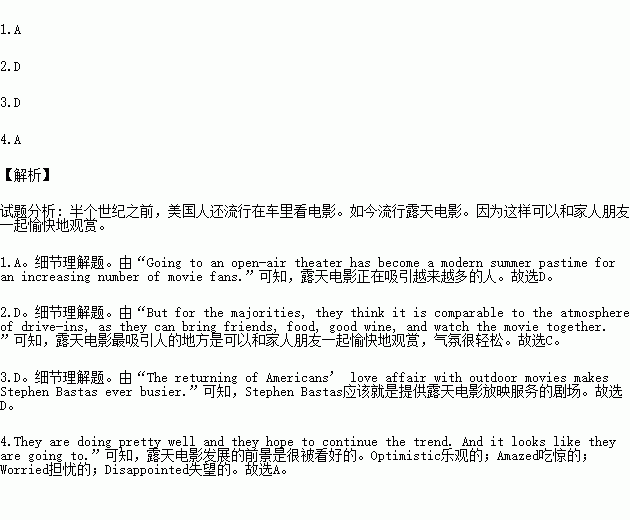题目内容
More than half a century ago, there were 4, 000 drive-in movie theaters in the United States, and watching a movie from your car was a popular way to spend an evening. But with the number of drive-ins reduced to just a few hundred, outdoor movie has been popping up across the nation. Going to an open-air theater has become a modern summer pastime for an increasing number of movie fans.
In recent years, outdoor movie screenings have come up in parks, vacant lots and shopping malls around the nation. On average, about 1,000 people attend each movie night. It attracts a lot of young professionals, young workers and residents nearby. For some, the outdoor movies bring back the memories of the drive-in theaters of their youths. But for the majorities, they think it is comparable to the atmosphere of drive-ins, as they can bring friends, food, good wine, and watch the movie together.
The returning of Americans’ love affair with outdoor movies makes Stephen Bastas ever busier. His seven-member crew sets up screens in various locations mostly in the Washington area every day throughout the summer. They are doing pretty well and they hope to continue the trend. And it looks like they are going to. That’s because many fans say there is nothing like watching a movie on a breezy summer evening under the stars.
1.In the first paragraph, the author tries to tell us _____.
A. outdoor movies attracts more movie-lovers
B. summer brings back more drive-in movie fans
C. drive-in movie theaters have already disappeared
D. watching a movie from your car is becoming more popular
2.Most people choose to go to an outdoor movie mainly because they can _____.
A. have snacks before the movie
B. cheer up with young friends
C. bring back good old days
D. enjoy the casual atmosphere
3.From the text, we can learn that Stephen Bastas is most probably _____.
A. a movie maker
B. an outdoor movie fan
C. a movie director
D. an open-air theater operator
4.How does Stephen Bastas feel about the future of outdoor movie?
A. Optimistic. B. Amazed.
C. Worried. D. Disappointed.
书面表达
假设你是红星中学高三(1)班的学生李华,你校正在招募志愿者,为春节期间中外学生交流活动做准备。请根据下表提供的信息,用英语写一封e-mail,向学校外事办公室提出申请。注意:1. E-mail的开头和结尾已为你写好。2. 词数不少于100。
Name | Li Hua |
Class | Class 1, Senior 3 |
Qualifications | speak English fluently have similar experiences be willing to spread Chinese culture …… |
Dear Sir,
I am writing to apply for a position as a volunteer.
Yours sincerely,
Li Hua


 st my younger brother and myself in the house. One evening Dad came home from and there was no food in the house, not a piece of bread. Although we were , my brother and I went to bed without eating anything.
st my younger brother and myself in the house. One evening Dad came home from and there was no food in the house, not a piece of bread. Although we were , my brother and I went to bed without eating anything.